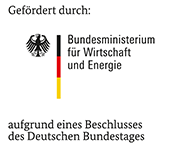16294N

| Period: | 2010-01-01 to 2012-06-30 |
|---|---|
| Funder: | Federal Ministry for Economics and Technology (BMWI, Germany) via AiF |
| Project Manager: | Christine Geers |
| Research Group: | High Temperature Materials |
To combine mechanical and thermal conductive properties of materials with the demands of chemical resistance in highly aggressive atmospheres at high temperatures, coatings are useful as surface modifications without a change of the bulk phase material. High carbon activity atmospheres at 400-900°C (e.g. in reformer or coal gasification plants) cause coking and metal dusting on steels and nickel base alloys by catalytic surface interactions. Besides general attack by metal dusting unpredictable pitting also occurs, which makes it impossible to calculate a proper lifetime model for materials in the process industry.
To stop the catalytic activation of carbon directly on the surface without changing the bulk phase, an intermetallic Ni-Sn phase will be presented. As well as iron and cobalt nickel is one of the main elements susceptible to metal dusting. Tin was chosen because of its position in the periodic table of elements, under carbon. This was important to ensure that the same orbitals of nickel are blocked, which would otherwise react with carbon. Another aspect is the interference of the crystal lattice parameters of nickel by tin. In previous publications graphite nucleation on nickel or cementite was correlated with epitaxial similarities between those species.
Initial exposure tests of Ni-Sn coated samples (coating thickness 7-10 µm) at 650°C under metal dusting conditions (74% H2 ; 24% CO; 2% H2O) showed great improvement especially for low alloy steels. The coating remains metallic during exposure as long as the oxygen partial pressure does not exceed 10-20 bar. This increases the adhesion to the bulk material compared to ceramic oxide layers. The material protection by this intermetallic coating for coking and metal dusting is to be used on low cost steels as an alternative to high alloy steels or nickel base alloys with high contents of oxide forming elements.
back
Das IGF-Vorhaben Nr. 16294N der Forschungsvereinigung DECHEMA e.V., Theodor-Heuss-Allee 25, 60486 Frankfurt am Main wurde über die AiF im Rahmen des Programms zur Förderung der industriellen Gemeinschaftsforschung (IGF) vom Bundesministerium für Wirtschaft und Energie aufgrund eines Beschlusses des Deutschen Bundestages gefördert.
PD Dr. Mathias Galetz
Tel.: +49 69 / 7564-397
E-mail: mathias.galetz
C. Geers, M. Galetz, M. Schütze, Surf. Coat. Tech. 215 (2013), 2
C. Geers, M. Schütze, in "Proceedings of Corrosion 2011" (2011), NACE
Final report (pdf, 4.5 MB, in German)